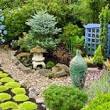
The Art of Designing Landscapes
Landscaping is more than just planting flowers and trimming hedges – it is an art form that involves careful planning, creativity, and a deep understanding of the natural environment. Designing landscapes allows us to transform outdoor spaces into beautiful and functional areas that enhance our quality of life.
One of the key elements of landscape design is creating a harmonious balance between hardscape elements, such as pathways, patios, and structures, and softscape elements like plants, trees, and flowers. The goal is to create a cohesive design that complements the architecture of the surrounding buildings while also integrating seamlessly with the natural features of the land.
When designing landscapes, it is important to consider factors such as sunlight exposure, soil quality, drainage patterns, and climate conditions. These environmental factors play a crucial role in determining which plants will thrive in a particular location and how to arrange them to create visually appealing compositions.
Another important aspect of landscape design is functionality. A well-designed landscape should not only be aesthetically pleasing but also serve practical purposes such as providing privacy, creating outdoor living spaces for relaxation and entertainment, or improving energy efficiency by shading buildings from the sun.
Whether you are designing a small urban garden or a large rural estate, the principles of landscape design remain the same. By carefully planning the layout, selecting appropriate plant species, and considering how each element will interact with its surroundings, you can create a landscape that is both beautiful and sustainable.
Ultimately, designing landscapes is about creating spaces that bring joy and inspiration to those who experience them. Whether it’s a peaceful garden retreat or a vibrant public park, well-designed landscapes have the power to enrich our lives and connect us with the natural world.
5 Essential Tips for Designing a Stunning and Sustainable Landscape
- Consider the climate and local weather conditions when selecting plants for your landscape.
- Create focal points in your design to draw attention and create visual interest.
- Use a variety of textures, colors, and heights to add depth and dimension to your landscape.
- Incorporate sustainable practices such as using native plants and efficient irrigation systems.
- Regular maintenance is key to keeping your landscape looking its best, so plan for upkeep tasks accordingly.
Consider the climate and local weather conditions when selecting plants for your landscape.
When designing landscapes, it is crucial to consider the climate and local weather conditions when selecting plants. Choosing plant species that are well-suited to the specific environmental factors of your region, such as temperature, rainfall, and sunlight exposure, will help ensure the success and longevity of your landscape design. By selecting plants that are adapted to thrive in your local climate, you can create a sustainable and low-maintenance landscape that will flourish year-round.
Create focal points in your design to draw attention and create visual interest.
Creating focal points in your landscape design is a powerful technique that can enhance the overall aesthetic appeal of your outdoor space. By strategically placing elements such as a striking sculpture, a colorful flower bed, or a unique architectural feature, you can draw the eye and create visual interest. Focal points not only add depth and dimension to your design but also help to guide the viewer’s gaze and create a sense of balance and harmony in the landscape. Whether you want to highlight a specific area of your garden or create a stunning focal point that serves as a centerpiece, incorporating focal points into your design can elevate the beauty and impact of your outdoor environment.
Use a variety of textures, colors, and heights to add depth and dimension to your landscape.
To enhance the visual interest of your landscape design, incorporate a diverse range of textures, colors, and heights. By mixing different plant varieties with varying leaf shapes, flower colors, and growth habits, you can create layers of depth and dimension in your outdoor space. Utilizing contrasting textures and colors adds richness to the landscape while varying plant heights help create a sense of scale and perspective. This tip not only adds visual appeal but also brings a dynamic and engaging quality to your garden or outdoor environment.
Incorporate sustainable practices such as using native plants and efficient irrigation systems.
Incorporating sustainable practices into landscape design, such as using native plants and efficient irrigation systems, is not only environmentally responsible but also beneficial for the overall health and longevity of the garden. Native plants are well-adapted to the local climate and soil conditions, requiring less water, fertilizer, and maintenance compared to non-native species. Efficient irrigation systems help conserve water resources by delivering water directly to plant roots where it is needed most, reducing waste and promoting healthier plant growth. By integrating these sustainable practices into landscape design, we can create beautiful outdoor spaces that thrive in harmony with nature while minimizing our impact on the environment.
Regular maintenance is key to keeping your landscape looking its best, so plan for upkeep tasks accordingly.
Regular maintenance is essential for preserving the beauty and health of your landscape design. By planning for upkeep tasks accordingly, you can ensure that your outdoor space continues to look its best year-round. From watering and fertilizing plants to pruning trees and cleaning pathways, staying on top of maintenance tasks will not only enhance the aesthetic appeal of your landscape but also contribute to the longevity of your plants and overall garden health. Remember, a well-maintained landscape is a reflection of your dedication and care for the natural environment around you.
